Most agar is extracted from species of Gelidium (Figure 1) and Gracilaria (Figure 2). Closely related to Gelidium are species of Pterocladia, and small quantities of these are collected, mainly in the Azores (Portugal) and New Zealand. Gelidiella acerosa is the main source of agar in India. Ahnfeltia species have been used in both Russia and Japan, one source being the island of Sakhalin (Russia).
First, a discussion is necessary of the terms used to describe where seaweeds grow. The vertical dimension of the shore is divided into zones. Common terms used to describe these are the intertidal zone and the subtidal zone. People are familiar with tides and readily understand these terms. The intertidal zone is the part of the shore that lies between the high and low tide levels, the subtidal zone is everything below the low tide level. Sometimes the intertidal zone is called the littoral zone. However, it has been found that, from a biologist's point of view, it is better to use terms that define the zones by what usually grows in them. So a line is drawn, and above this line is a zone where organisms receive irregular wetting and this is called the eulittoral zone. Below this line, organisms are immersed in water except on rare occasions (e.g. extremely low tides); this is called the sublittoral zone. These zones do not necessarily depend on tide levels; the upper limit of the eulittoral zone is set by the upper limit of barnacles, where they occur, and the lower limit is the highest point where the large brown algae can be found growing. Above the edge of the eulittoral zone, beyond the barnacles, is a zone that is only reached by spray water and this is called the littoral fringe.
FIGURE 1
Gelidium, rehydrated from dried material purchased by an agar producer.
The coin diameter is 20 mm.
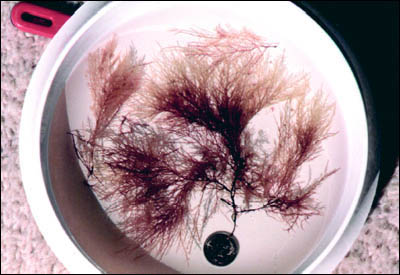
FIGURE 2
Gracilaria, rehydrated from dried material purchased by an agar producer.
The coin diameter is 20 mm.
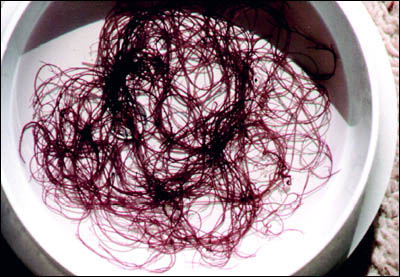
Gelidium grows best where there is rapid water movement, which is in the eulittoral and sublittoral zones. Depending on the species, it can be found in water from 2 to 20 m in depth. Gelidium prefers rocky areas with steep slopes, and is rarely found on muddy or sandy bottoms (compare Gracilaria below). It prefers partial shade and may be bleached by full intensity light in tropical latitudes. It usually grows best at 15-20°C, but can tolerate higher temperatures. It can survive in low nutrient conditions and some species adapt to low or high salinity.
For further detail see Santelices (1991).
Large beds of Gracilaria usually grow in the eulittoral zone, or just below it in the beginning of the sublittoral, on sandy or muddy sediments that are protected from waves. Sometimes it can be found free-floating in tidal lakes of salt or brackish water. It can adapt to large variations in growing conditions, such as freshwater dilution, increase in fertilizer concentration from runoff, and raised temperatures. Seawater temperatures of 20°C or higher are needed for at least three months of the year. It grows in a wide range of latitudes. It can survive being covered in sediment - growing again when water motion uncovers it.
The harvests of Gelidium are spread over a wide geographical area. Large quantities are harvested on the north coast of Spain, the middle to southern end of the coast of Portugal, and the west coast of Morocco. Smaller amounts are found on the Bay of Biscay coast in the southwest of France. Prior to the Second World War, the Gelidium of Japan was the main source of the world's agar, but industrialization has led to depletion of the natural stocks, and today Japan harvests similar quantities to countries like Spain and Morocco. The Republic of Korea harvests commercial quantities for its local industry, in an area around the southern port of Pusan. In Mexico, Gelidium is harvested on the Pacific coast of Baja California. Warm-water species are collected from natural beds on the south coast of Java, Sumatra and many of the islands of Indonesia that lie between Java and Timor. Less significant contributors to the total harvest of Gelidium are Chile, China, France and South Africa.
For further details see McHugh (1991), and for an update on individual countries see Critchley and Ohno (1998).
Gracilaria is also distributed widely, with some species adapted to tropical countries like Indonesia, others to colder waters such as southern Chile and the Atlantic coast of Canada. Chileans pioneered the commercial cultivation of Gracilaria, using Gracilaria chilensis, native to its southern coast and containing a high quality agar. There are also large beds of wild Gracilaria in Chile, and it was the fear of depletion of these beds by overharvesting that led to the development of cultivation. Wild Gracilaria is also harvested in Argentina and Brazil, although the quantity is decreasing in Brazil because the quality does not compare well with the Chilean product.
China produces significant quantities of Gracilaria, mainly in the southern provinces of Guangxi and Hainan, where it is cultivated in ponds and estuaries; it is also cultivated in Taiwan Province of China. In Indonesia, wild seaweed is collected and some is cultivated in ponds. A more concerted effort appears to have been made in Viet Nam in recent years, with a variety of species being grown in lagoons and ponds in both the north and south. Beach-wash Gracilaria has been collected near Luderitz (Namibia) for a number of years, and, more recently, successful cultivation has been achieved in Luderitz Bay. Since the Second World War, wild seaweed has been collected from Saldanha Bay on the west coast of South Africa, but the yearly harvest has shown wide fluctuations. In southern Thailand, a source of income for women is the collection of free floating Gracilaria from tidal lakes and lagoons (Figure 3).
For Gelidium, the harvesting methods used in Spain and Portugal are typical of the industry. A high percentage of the harvest comes from the gathering of storm-cast seaweed. This is often done by two people dragging a net to capture the seaweed; for cast material that has settled to the bottom in shallow bays, boats may be used to drag the nets. Sometimes significant quantities of cast seaweed collect in depressions in the sea floor and this is collected using a suction tube, put in place by a diver, to draw the material up and into a boat.
The harvesting of material that is still attached to the rock is often done by divers, who pluck off the seaweed and stow it in net bags or baskets, which are hauled into the service boat when full. However, plucking can lead to complete removal of the plant, and then regeneration of the beds is slower. The seaweed is held onto the rock by a holdfast, a structure that often consists of many finger-like pieces that are called rhizoids. It is important for some rhizoids to be left on the rock so the Gelidium can regrow. Machines, held by divers, for cutting or mowing the seaweed bed have been devised, usually with an attachment that sucks the cut weed up and into a boat. While the machines are expensive, they have the advantage of not damaging the holdfast and rhizoids, allowing faster recovery of the beds, which also show an increased mass of seaweed when they regrow. In several countries, such as Chile and Indonesia, most of the harvest is from attached weed that is picked by hand either at low tide or by snorkelling in shallow waters.
For Gracilaria that is growing on the bottom, as the plant enlarges it provides more resistance to water movement and may eventually break off, leaving some of the plant in the sediment or sand to grow again. The broken pieces drift and may be collected by nets or are picked up after they wash onto the shore. Raking the beds from a boat is also practised, but care is needed or the sea bottom may be damaged, leaving little residual plant to grow again. A harvesting strategy is needed to preserve Gracilaria beds, and this should take into consideration the best time or season to harvest, the harvesting frequency, the method used (such as dragging or plucking), the harvesting tools and the need to leave some material unharvested so that regrowth can occur. The farmgate price (price paid to the collectors) of Gracilaria varies with demand and collectors usually respond with heightened activity and a tendency to overharvest when the price is high, so there is a need to have an enforceable harvesting policy to preserve the natural beds. In Argentina, Gracilaria is gathered from large quantities brought ashore by storms; it is not harvested from attached material.
FIGURE 3
Negotiating a price for dried Gracilaria. Women derive an income from
Gracilaria collection in southern Thailand.
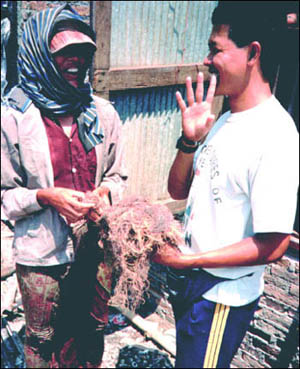
Gelidium species are small, slow growing plants, and while cultivation in ponds and tanks is possible, to date it has not been economically viable. The only exception appears to be in the case of a Canadian company based near Vancouver, Marine Bioproducts International Corp. It claims to be growing a consistent, high quality Gelidium from which it produces speciality high grade agar and agarose products that presumably can be sold at a premium price to offset the costs of cultivation (details at www.marbio.com).
Gracilaria cultivation is widespread, and several methods are used. It can be grown vegetatively (i) in open waters on the bottom of bays, estuaries or reef flats; (ii) on lines, ropes or nets; (iii) in ponds; or (iv) in tanks. It has also been grown from spores, involving an alternation of generations and the need for nursery tanks to allow the germlings to grow before planting them out into the sea. The first three methods, (i) to (iii), are the most widely used ones.
Where the open-water bottom is a soft sediment, such as an intertidal mudflat or an estuary outlet, pieces of seaweed are forced into the sediment using a "y"-shaped fork planting tool, either by a diver or from a boat using a long wooden handle with the fork on the end. The buried portion of the plant grows laterally, anchoring the plant, and it also produces vertical shoots that develop into mature plants. When the bottom is sandy, forked pieces loosen before they can become established by growing new lateral shoots, so to overcome this a different method is used. Tubular plastic bags, about 1 m long by 30-40 cm diameter, are filled with sand, and pieces of seaweed are wound around the tube or fixed to it with an elastic band. The tubes are then placed on the sea bottom and the plant is held in place as it forms new horizontal shoots. Eventually the plastic bag disintegrates, but by then the plant is firmly attached to the bottom. However, the accumulation of large quantities of disintegrated plastic tubes, washed up on nearby shores, can be a problem. Other methods have included fixing pieces of seaweed to rocks using rubber bands or nylon mesh to hold it in place on the rock, and then placing the rocks on the sea bottom.
For further detail, Buschmann, Westermeier and Retamales (1995) give a summary of experiences with sea-bottom farming in Chile; see also the more general references at the end of this section.
Line or rope farming was pioneered in China in the 1950s for the cultivation of brown seaweeds, and the method has been adapted to several other genera, including Gracilaria. Pieces of Gracilaria are fixed to a rope or monofilament line such as nylon. The rope needs to be stable when exposed to sunlight and salt water for long periods; polypropylene rope is often used. The seaweed can be attached by untwisting the rope to open the lay, inserting the plant and then allowing the rope to twist back to its natural position. Or the plant may be tied to a monofilament line, or a rope, with another piece of "string" - often a plastic raffia is used. The line is then stretched in the water between two stakes driven into the bottom. Success depends on the selection of farm site (suitable water flow, nutrient availability and water temperature) and positioning of the line in relation to water depth and light intensity. These are general guidelines, and adjustments must be made for each site. Nets can be used in place of ropes, but people generally find ropes are more convenient. Sometimes the ropes or nets are fixed to frames made from bamboo, giving a raft type structure (see Figure 42) that is anchored to the sea bottom and held at a fixed depth with floats.
Pond cultivation of Gracilaria is less labour intensive than rope farming (no need to fix many pieces to a rope or net) and has been quite successful, originally in China in Guandong, Hainan and Taiwan Province of China, now also in Indonesia, Viet Nam and in experimental trials in Malaysia. One disadvantage of Gracilaria from ponds is that the agar extracted from it is often of low gel strength and so only attracts the lower price of a food grade agar. Ponds are usually no larger than a hectare, preferably 0.5-1.0 ha. Pieces of fresh seaweed, either gathered from natural beds or nearby ponds, are broadcast evenly over the pond surface and allowed to sink to the bottom. Because the Gracilaria is not fixed in any way, any wind motion of the water will drive the plants to one side of the pond. This even occurs in small ponds, so an area that is not exposed to strong winds is preferable. Ponds need access to both salt and freshwater so that the salinity can be adjusted and so that the water can be changed every 2-3 days. Water change is usually made using tidal flows, with gates to control the water flow in and out.
Frequently, old shrimp or fish ponds are used (Figure 4). The pH of the pond water is important, and newly constructed ponds are often too acidic and must be left to rest until the pH is just slightly alkaline (pH 8). Pond depths are usually 60-70 cm, but the water level may be varied according to the air temperature. The preferred water temperature is 15-30°C so, for example, in the summer of Taiwan Province of China, if the air temperature rises above 30°C, the water depth is increased to 50-60 cm to protect the seaweed from hot surface temperatures. In the colder winter months, the water level may be reduced to 20-30 cm to allow warm water to reach the bottom.
Harvesting is possible every 35-45 days depending on the seasonal growth rate. About half the seaweed is harvested, usually by people wading through the pond, scooping it off the bottom into nets and placing it on a wooden raft or floating basket (Figure 5). The plants remaining form seed material for the next crop, and are broken into smaller pieces and broadcast over the pond. The harvested material is often laid around the banks of the pond to dry in the sun for 2-3 days (Figure 4), although a cleaner product is obtained by drying away from the ground (Figure 6).
An epiphyte is a plant that grows on another plant but is not parasitic on it. Epiphytes can be a problem in all seaweed cultivation since they contaminate the crop unless they are removed. In the pond cultivation of Gracilaria, epiphytes can be a particular problem because the growing seaweed is not readily accessible to the farmer, as it lies on the bottom of the pond. Contrast this with cultivation on lines, where the farmer can periodically move along the lines and physically remove epiphytes at an early stage of contamination. Sometimes Gracilaria is grown in ponds with other marine species, such as tilapia or milkfish, that will control the epiphytes by grazing on them. This and other types of polyculture are discussed in more detail in a later section (Section 9.6).
FIGURE 4
Pond used for Gracilaria cultivation, Sulawesi, Indonesia.
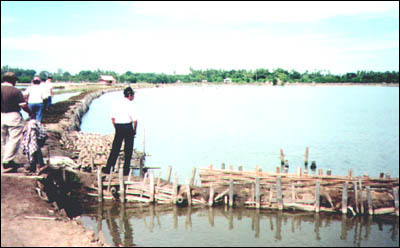
FIGURE 5
Harvesting Gracilaria from pond cultivation, Sulawesi, Indonesia

FIGURE 6
Drying Gracilaria, off the ground, Pattani, southern Thailand.
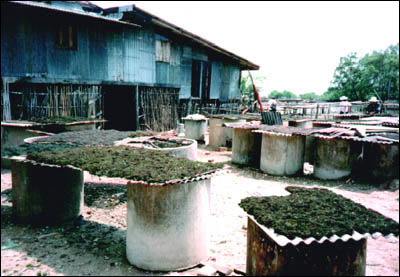
For further detail on epiphytism, see a review of epiphytism and its control in Gracilaria farming in Fletcher (1995).
Tank cultivation of Gracilaria has been studied by several groups. Because other methods of cultivation are relatively labour intensive, in developed countries it was thought that tank cultivation of unattached plants might be the answer to their high labour costs. However, it has not been adopted on a commercial scale because of the costs involved. The method is very energy intensive because of the need for aeration and large amounts of flowing seawater. Nutrients must also be added, and sometimes the temperature needs to be controlled, particularly in hot climates. Commercial scale production also brings a requirement for large areas of coastal land, and this can be very expensive in developed countries.
For further details
The cultivation of Gracilaria has been the subject of some very good reviews that give details of the processes involved and useful explanatory diagrams. See Ohno and Critchley (1993), Santelices and Doty (1989), Oliveira, Alveal and Anderson (2000), and Buschmann et al. (2001).
In addition, the June 1995 issue of the Journal of Applied Phycology is devoted to 10 papers given at a workshop on Gracilaria and its cultivation; each of the following papers is useful for the particular topic, which can be found in its title (see list of References): Buschmann, Westermeier and Retamales (1995); Dawes (1995); Friedlander and Levy (1995); and Fletcher (1995).
For Gracilaria, Chile is the largest supplier, although the harvest of wild seaweed has fluctuated over the last 5 years, from 121 000 wet tonnes in 1996 down to 73 000 tonnes in 1998, and back up to 137 000 wet tonnes in 2000. Cultivation has yielded about 33 000 wet tonnes for the last two years for which figures are available (1999 and 2000). China, Indonesia, Namibia and Viet Nam all supply between 12 000 and 18 000 wet tonnes each, in most cases from a mixture of wild and cultivated material. In Argentina, between 1985 and 1995, the harvest of dried Gracilaria varied from 1 700 to 3 100 tonnes. In India, harvests of wild Gracilaria and Gelidiella on the Tamil Nadu coast have varied between 750 and 1 300 dry tonnes from 1996 to 1999.
For Gelidium, the main suppliers in Europe are Spain and Portugal; in Africa, it is mainly from Morocco, with some from Namibia and South Africa. The principal contributors from Asia-Pacific are Japan, the Republic of Korea and Indonesia, while from the Americas it is Mexico.
Quantities harvested from the principal source areas are shown in Table 1.
TABLE 1
Agarophyte resources harvested in 2001 (tonnes dry weight)
|
Gracilaria |
|
|
Europe |
200 |
|
Africa |
300 |
|
Americas |
25 000 |
|
Asia-Pacific |
11 500 |
|
Subtotal |
37 000 |
|
Gelidium |
|
|
Europe |
6 600 |
|
Africa |
7 200 |
|
Americas |
500 |
|
Asia-Pacific |
4 300 |
|
Subtotal |
18 600 |
|
Pterocladia |
|
|
Europe |
50 |
| Total |
55 650
|
Source: H. Porse, CP Kelco ApS, 2002, pers. comm.
Gelidium is sold to agar producers. In Japan, Mexico, Morocco, Portugal and Spain, the harvests are sold to local agar companies. Gelidium is such an excellent source of high quality agar that there is always a strong demand from any agar producer in the country of origin. However, price is always a determining factor and, for example, Spain has imported Gelidium from South Africa and Chile when the local price was too high. Indonesian Gelidium is used by local agar producers and some is also exported, mainly to Japan. Chile and South Africa both sell Gelidium to the producers in Europe and Japan; according to official statistics, Gelidium is not extracted in Chile and there are no agar producers in South Africa.
Chile has six exporters of Gelidium, listed by ProChile, but two of these dominate the trade: Industria Pesquera Costa Azul S.A., Vina del Mar; and Midesa S.A.C., Santiago.
A South African exporter is Taurus Products (Pty) Ltd, Johannesburg.
The numbers and names of Indonesian exporters of Gelidium fluctuate and current information is best obtained from the Indonesian Seaweed Industry Association (APBIRI) (See Section 3.2).
Gracilaria is sold to agar producers and some is used as food. For food consumption, the seaweed is usually gathered and sold fresh, locally. It is most common in South-East Asian countries such as Indonesia, Malaysia, the Philippines and southern Thailand, mainly in coastal communities. It is also popular with most ethnic groups in Hawaii, and is sold fresh in Honolulu markets as limu manauea or limu ogo.
Agar producers usually buy dried Gracilaria, but some buyers, particularly from Japan, are now requiring alkali-treated, dried seaweed. Historically, Japan produced agar by extracting the seaweed, Gelidium, with hot water and then freezing the extract by placing it outside in the winter sub-zero temperatures. Consequently several agar producers are located in mountainous districts of Japan, where it is becoming increasingly difficult to dispose of waste waters. To obtain a good quality agar from Gracilaria, it is necessary to treat it with alkali before the hot water extraction (more details in Section 3), and it is the disposal of these alkaline waste waters that is posing environmental problems. Buying Gracilaria that has already been treated with alkali overcomes this problem for Japanese producers. However, it means that some exporters now have to set up alkali treatment facilities in their own countries. Japan imports Gracilaria mainly from Chile, Indonesia, Namibia, the Philippines and South Africa. Other importers are Argentina, the Republic of Korea and Spain. Chile is the largest exporter of Gracilaria, but also uses appreciable quantities itself; in the case of Indonesia and Viet Nam, each uses about one-third of its production, exporting the remainder. Other exporters include Namibia and South Africa.
Chile lists 21 exporters of Gracilaria, the largest ones being Algas Vallenar S.A., Vallenar; Algas, Cultivos, Exportaciones - Acex S.A., Santiago; Alimentos Multiexport S.A., Santiago; and Midesa S.A.C., Santiago. For up-to-date information on Chilean exporters, consult the latest annual Export Directory, published by ProChile, Santiago.
A South African/Namibian exporter is Taurus Products (Pty) Ltd, Johannesburg.
The numbers and names of Indonesian exporters of Gracilaria fluctuates and current information is best obtained from the Indonesian Seaweed Industry Association (APBIRI) (See Section 3.2).
Sales depend on the prosperity of the agar industry, and since it has a stable market with limited prospects of expansion, agarophytes in general are in a similar position. However, the market for Gelidium and Pterocladia will always be competitive because they provide the best quality agar and are only available from limited natural resources. Since the cultivation of Gracilaria has been so successful, this means that any expansion that does occur in the agar market can be readily serviced by growing more Gracilaria. At present the producers and collectors of Gracilaria are therefore likely to face a buyers market, bringing pressure to reduce prices.